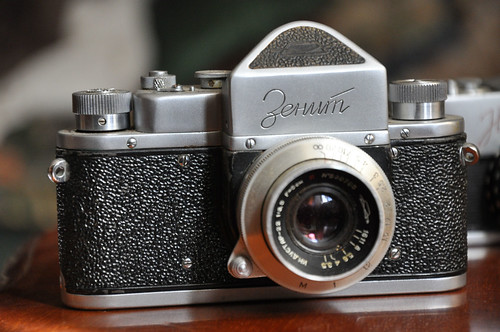Zenit 1
Zenit - KMZ
The Zenit 35mm SLR camera hails from the USSR during the cold political climate of the early 1950’s, the manufacturer was the KMZ established in 1941 outside Moscow. This first model (sometimes called the Zenit 1) was produced between 1952 and '56. It is a particularly sturdy and clever little camera based on the Zorki rangefinder, and following the original Leica camera concept, but taken one step further to become a true SLR with a fixed eyelevel pentaprism finder, yet rather basic in the mechanical design department, and it arrived too early for the upcoming innovations. The lens mount is a 39mm screw thread, but the film register is longer than in Leica rangefinders (in order to allow room for the mirror of the SLR); this excludes the use of Leica fit lenses except for close up work. The removable base plate is identical in size to that on the Leica, but not interchangeable (it is identical to that on the Zorki of the same age). The outer body, including the mirror housing, is a one piece alloy casting, the top cover is in two pieces, while inside, the shutter crate is a separately cast unit. The shutter is a cloth focal-plane one, very like that on the Zorki rangefinder cameras.
The standard lens is either an Industar-22 or an Industar-50. Both are 50 mm f/3.5 coated Tessar-type lenses[1].
The KMZ is one of the early pioneers in the field of 35mm SLR’s, Zenit being the ninth 35mm SLR camera brand introduced, excluding a few exotic and scarce models, mainly from central Europe, and it is the second to appear from this country, the first being the less impressive GOMZ Sport. Its better known contemporaries are the Asahiflex and the Contaflex.
The Zenit, the name engraved in Cyrillic letters on the prism housing front, is the first in a long and popular series of cameras gradually evolving throughout the remaining period of the past century. The first improvement was to include flash synchronization with the model Zenit C C. A new and improved camera body (the Zenit 3) was introduced in 1960, with a hinged back for easier film loading, at the expense of a somewhat larger body.
The Zenit
1952-1956 39.019 units
Notes
- ↑ See these and other lenses for M39 Zenit cameras at Zathan Dayton's 'Communist Cameras'
Links
In Russian: Zenit 1 camera line archive page at Zenit-Camera.com
